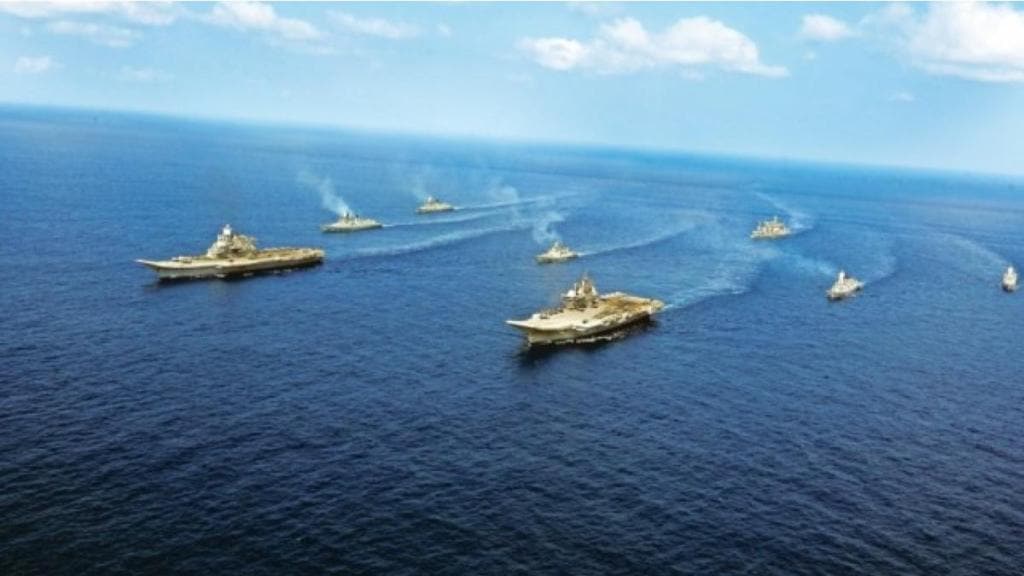The Indian Ocean Region (IOR), a bustling corridor for global trade and energy supply chains, faces mounting threats from piracy and illicit trafficking. From narcotics smuggling to piracy, these challenges demand a vigilant and coordinated response, which India has positioned itself to lead through the robust capabilities of its Navy and Coast Guard.
The Twin Menace of Smuggling and Piracy
The Indian Navy has been at the forefront of tackling the covert operations of drug smugglers, who often use sea routes to fund anti-national and terrorist activities. According to Admiral Sunil Lanba (Retd), former Chief of the Naval Staff, operations targeting these networks are inherently intelligence-driven, requiring close cooperation between maritime forces and agencies such as the Narcotics Control Bureau (NCB). “Timely and actionable intelligence is key,” he said, emphasizing the importance of collaboration among multiple stakeholders, including the Coast Guard, Marine Police, and Customs authorities.
The scale of the issue is daunting. The interception of a dhow carrying 940 kilograms of drugs, including methamphetamines and heroin, by INS Talwar during Operation Crimson Barracuda under the Combined Maritime Forces (CMF) highlights the Navy’s proactive role. This international coalition of 46 nations amplifies India’s capacity to combat organized smuggling and piracy networks.
Piracy: A Persistent Threat
Although piracy has declined since its peak near the Somali coast, vulnerabilities persist in regions like the Gulf of Aden and the Arabian Sea. Vice Admiral Biswajit Dasgupta (Retd) noted that piracy and drug smuggling, though lower on the spectrum of conflicts, have outsized implications for national security. The Indian Navy’s consistent anti-piracy patrols since 2008 have not only reduced incidents but also led to the reclassification of high-risk areas, ensuring safer trade routes.
The Indian Navy’s Multi-Pronged Strategy
The Navy employs a layered approach to address these maritime challenges:
- Maritime Patrols and Escorts: Warships escort merchant vessels through high-risk zones, particularly in the Gulf of Aden, ensuring the uninterrupted flow of global trade.
- Maritime Intervention Operations (MIOs): Elite MARCOS commandos are deployed for counter-piracy and rescue missions, showcasing the Navy’s rapid-response capabilities.
- Proactive Engagement: The Navy maintains a visible presence through forward-deployed warships, leveraging surveillance technology like UAVs and maritime patrol aircraft for real-time intelligence.
- International Collaboration: Partnerships with coalitions such as CMF and initiatives like the Shared Awareness and Deconfliction (SHADE) mechanism enhance interoperability with foreign navies.
Beyond Piracy: Combating Smuggling Networks
Drug trafficking, a lucrative revenue stream for criminal and terrorist organizations, poses a grave threat to regional stability. Strategic affairs expert Manan Bhatt observed that sophisticated smuggling routes and the involvement of transnational actors point to an intricate network aimed at destabilizing nations like India.
Seizures such as the one during Operation Crimson Barracuda disrupt these operations and send a strong deterrent message. Commander Rahul Verma (Retd), a maritime security analyst, highlighted the Navy’s integration of advanced technologies to monitor vast swathes of ocean and respond swiftly.
The Road Ahead
Despite significant progress, gaps remain in India’s maritime security framework, particularly in integrating coastal police capabilities with national strategies. The lessons of the 26/11 Mumbai attacks underline the importance of cohesive efforts across all maritime security layers.
As a resident power in the Indian Ocean, India’s maritime leadership is not merely about ensuring domestic security but also about safeguarding global trade and energy supply chains. The Indian Navy’s success in countering piracy and smuggling underscores its growing stature as a net security provider in the region, reinforcing India’s commitment to stability in the Indo-Pacific.
This rising tide of criminality in ocean waters is a call to action, one that India’s maritime forces are answering with commendable resolve and strategic foresight.


